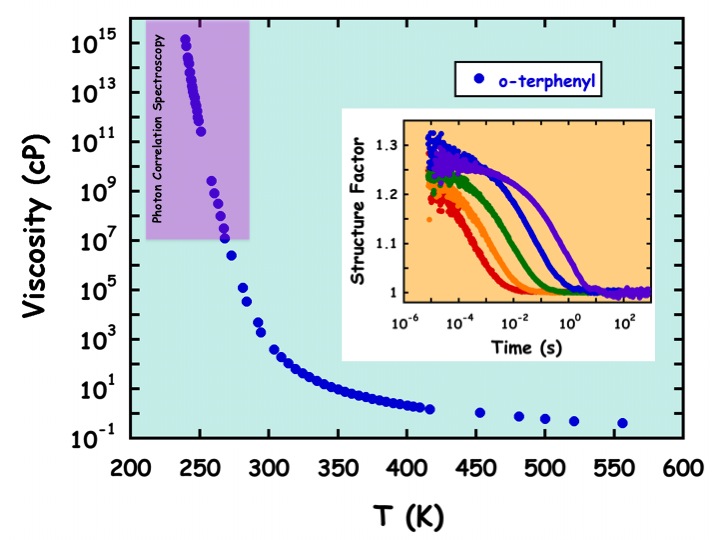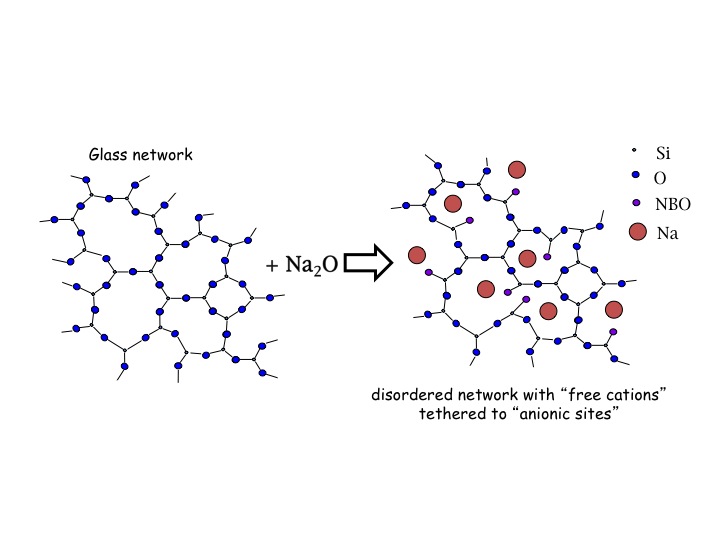Research Interests
Research InterestsThe majority of the research in the Condensed Matter Group involves exploration of dynamics in complex materials using a variety of spectroscopy techniques. Both undergraduate and graduate students are trained in these techniques and are actively engaged in the research.
Carbon Nanodots
Carbon NanodotsPhoton correlation spectroscopy measures the effective radius of aggregating sugar clusters. These sugar clusters serve as the precursor for the production of larger-than-normal carbon "dots" with unique photoluminescence properties.
Our PCS studies of simple sugars (glucose, sucrose and trehalose) in water show a remarkable propensity for the formation of sugar clusters with the onset of a gel phase at weight percents in excess of 85% sugar. Moreover, when overheated these solutions assume a brown tint due to the formation of carbon particles that appear to be some 2 orders of magnitude larger than the sugar clusters they are formed from. This conversion to carbon is accompanied by an intense fluorescence commonly found in much smaller (nanometer-sized) carbon "dots". Current efforts are directed at understanding how these larger particles manage to share properties similar to their smaller-sized cousins.
Supercooled Liquids
Supercooled Liquids  Ortho-terphenyl is a common example of the radical increase of viscosity that occurs near the glass transition of a supercooled liquid. Photon correlation spectroscopy probes the viscoelastic relaxation present in the liquid's dynamic structure factor for times between about 1 microsecond to 100's of seconds.
Ortho-terphenyl is a common example of the radical increase of viscosity that occurs near the glass transition of a supercooled liquid. Photon correlation spectroscopy probes the viscoelastic relaxation present in the liquid's dynamic structure factor for times between about 1 microsecond to 100's of seconds.
While we are most familiar with liquids, like water, that crystalize when cooled below their freezing points, most all substances (including water) can be cooled without crystalliztion into an amorphous (i.e., glass) state wherein the particles appear like a liquid but are no longer able to flow. The transition from liquid to glass remains an active field of inquiry and is ranked among some of the top unsolved questions in physics. In our lab, we are employing dynamic light scattering to investigate the demise of the liquid state as particle motions slow from microseconds to 100s of seconds. Our current efforts are directed at understanding how these slow dynamics are related to details of the bonding in oxide and chalcogenide glass formers.
Ion Conduction in Amorphous Solids
Ion Conduction in Amorphous Solids
Driven in part by a global need for advanced energy storage technologies (i.e., batteries), researchers continue to explore the nature of ion motions in non-crystalline materials including polymer electrolytes and ion-conducting glasses. Past research activities focussed on understanding the self-similar properties of ion conductivity seen in frequency-dependent impedance measurements and their possible connection with the structure of the amophous matrix. More recent work has focussed on the origins of the so-called 'nearly constant loss' which is universally observed in ion conductors at extremely high frequencies or extremely low temperatures.
Recent Publications
Recent PublicationsBooks
D. L. Sidebottom, Fundamentals of Condensed Matter and Crystalline Physics, (Cambridge University Press, 2012).
D. L. Sidebottom, Dynamic Light Scattering in Characterization of Materials, 2nd Ed. edited by E. N. Kaufmann (John Wiley and Sons, in press).
Reviews
D. L. Sidebottom, “Understanding Ion Motion in Disordered Solids from Impedance Spectroscopy Scaling,” Rev. Mod. Phys. 81, 999 (2009).
J. C. Dyre, P. Maass, B. Roling and D. L. Sidebottom, “Fundamental Questions Relating to Ion Conduction in Disordered Solids,” Rep. Prog. Phys. 72, 046501 (2009).
Refereed Publications
D. L. Sidebottom and S. E. Schnell, "Role of intermediate-range order in predicting the fragility of network-forming liquids near the rigidity transition." Physical Review B 87, 054202 (2013).
D. L. Sidebottom and M. Bassett, “Nearly Constant Loss in Lithium and LiCl-doped Borate Glasses,” Z. Phys. Chem. 223, 1141 (2009).
R. Fabian, Jr. and D. L. Sidebottom, “Dynamic Light Scattering in Network-forming Sodium Ultraphosphate Liquids near the Glass Transition,” Phys. Rev. B 80, 064201 (2009).
J. R. Changstrom and D. L. Sidebottom, “Study of the Mixed Alkali Effect in Lithium and Sodium Metaphosphate Glassforming Liquids by Photon Correlation Spectroscopy,” J. Phys.: Condens. Matter 20, 285103 (2008).
D. L. Sidebottom and J. R. Changstrom, “Viscoelastic Relaxation of Molten Phosphorus Pentoxide using Photon Correlation Spectroscopy,” Phys. Rev. B 77, 020201 (2008).
D. L. Sidebottom, “Ultraslow relaxation of hydrogen-bonded dynamic clusters in glass-forming aqueous glucose solutions: A light scattering study,” Phys. Rev. E 76, 011505 (2007).
D. L. Sidebottom, B. V. Rodenburg and J. R. Changstrom, “Connecting Structure and Dynamics in Glass Forming Materials by Photon Correlation Spectroscopy,” Phys. Rev. B 75, 132201 (2007).
B. V. Rodenburg and D. L. Sidebottom, “Dynamic Light Scattering in Mixed Alkali Metaphosphate Glassforming Liquids,” J. Chem. Phys. 125, 024502 (2006).
D. L. Sidebottom, “Constriction Effect in the Nearly Constant Loss of Alkali Metaphosphate Glasses,” Phys. Rev. B 71, 134206 (2005).
D. L. Sidebottom, “Structural Influences upon the Dynamic Light Scattering from Glassforming Liquids,” Ceramic Transactions 170, 93 (2005).
D. L. Sidebottom, “Scaling Properties of Ion Conduction and What They Reveal About Ion Motion in Glasses,” Proceedings of the 1st International Discussion Meeting on Solid Ion Conducting Physics (Kyoto, September 2003) (published by World Scientific Publishing, 2007).
E. Metwalli, M. Karabulut, D. L. Sidebottom, M.M. Morsi, and R. K. Brow, “Properties and Structure of Copper Ultraphosphate Glasses,” J. Non-Cryst. Sol. 344(3), 128-134 (2004).
D. L. Sidebottom, “Influence of Glass Structure on the ac Conductivity of Alkali Phosphate Glasses,” J. Phys.: Condens. Matter 15, S1585 (2003).